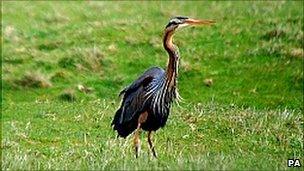First purple herons at RSPB Dungeness site hatch chick
- Published

Adult purple herons are recognisable by the dark stripes normally seen along the neck
A chick emerged from the nest of what is thought to be the first pair of purple herons to breed in the UK.
The Royal Society for the Protection of Birds (RSPB) said the bird was seen climbing up willow bushes, apparently to try to gain height before flying.
Volunteer Phil Eglise, who was on watch at the charity's nature reserve in Dungeness, said he watched the young heron for up to an hour.
He said it managed to fly a couple of circles before disappearing again.
He said: "It was practising flapping its wings before flying around in a couple of brief circles above the nesting reed bed.
"The sighting lasted about 45 minutes to an hour in total. The heron then disappeared again into the tall reeds."
'Second chick to come'
The RSPB said the behaviour, which has not been seen in either of the adult birds, confirmed that the sighting was of a fledgling.
The young heron also had a very brown and dull appearance, and lacked the dark stripes which are normally seen along an adult's neck.
It is thought there is at least one more chick to come, the RSPB said.

Climate change is pushing the birds further north from continental Europe
The adult male has been seen visiting the nest every few hours with food, and the female remains largely unseen, as she has done since the eggs were laid.
Volunteers are carrying out daily watches in case of any further sightings.
A round-the-clock species protection scheme was set up at the end of April after first signs that the herons were nesting at the site.
Kent Police helped the RSPB to monitor the nest, and officers warned that any attempt to damage the nest or remove eggs would be a criminal offence.
Winters in Africa
Increased activity and regular feeding in June suggested that chicks had hatched.
A month later, chicks could be heard in the nest.
According to the RSPB, purple herons have been struggling in Europe over the past few decades, and are expected to be seen more in the south of England as climate change pushes them north.
It is thought there will be more breeding pairs in the UK, in years to come.
The purple heron is closely related to the larger and widespread grey heron and can reach 35in (90cm) in height with a wingspan of up to 60in (150cm).
In continental Europe, the migratory purple heron usually breeds in reed beds, feeds in wetland areas on insects, reptiles, amphibians and other small animals, and winters in Africa.